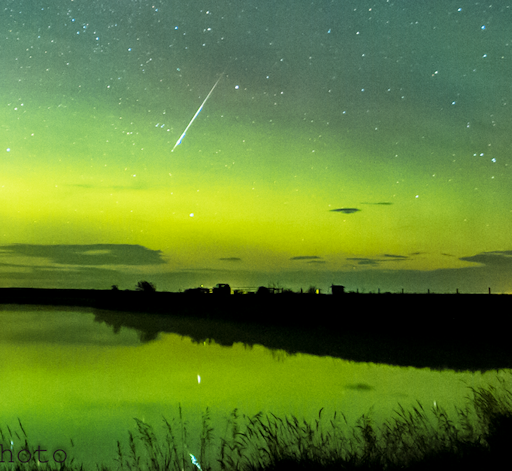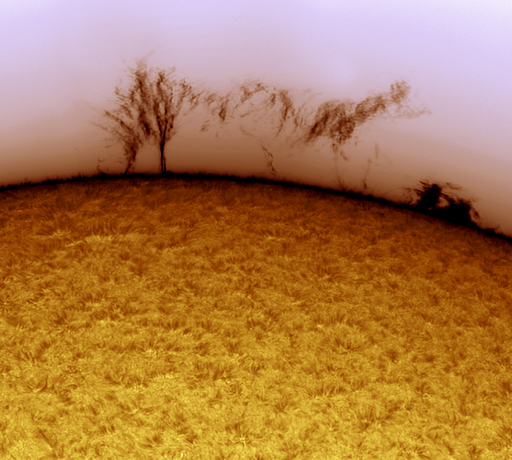Directly under the Arctic Circle! Marianne's Arctic Xpress in Tromsø offers fjord, whale and wildlife tours by day, aurora tours by night. Book Now and get a 10% discount on combo day and night adventures. | | | CELESTIAL TRIANGLE: Before the Perseid meteor shower begins tonight, there's something else to see. Step outside at sunset and look south. The Moon, Mars and Saturn have gathered to form a bright triangle in the twilight sky. Don't miss it! [sky map] PERSEID METEOR OUTBURST--TONIGHT! Earth is approaching a thicket of debris from comet Swift-Tuttle, source of the annual Perseid meteor shower. When Earth plows through the debris field on Aug. 11-12, the fireworks will begin. Forecasters expect an outburst of Perseid meteors numbering 200+ per hour. Scroll past this photo of an early Perseid, taken by Harlan Thomas on August 10th northeast of Calgary, for more information and observing tips: 
"Although I was a day early, I didn't want to miss a chance to see the Perseids," says Thomas. "I got more than I bargained for--10 to 15 Perseids per hour and auroras, too!" Meteor rates tonight could be 20 times what Thomas saw. Observing tips: Go outside between midnight and dawn on the morning of Aug. 12th. Allow about 45 minutes for your eyes to adjust to the dark. Lie on your back and look straight up. Perseids can appear anywhere in the sky, but their tails will point back to a single point in the constellation Perseus: sky map. Increased activity may also be seen on the morning of Aug. 13th. Got clouds? NASA is planning a live broadcast of the Perseid meteor shower overnight on Aug. 11-12 and Aug. 12-13, beginning at 10 p.m. EDT. You can also listen to radar echoes from the Perseids on Space Weather Radio. More webcasts: from Israel, from Alabama. Realtime Perseid Photo Gallery LIFT OFF: For days, astronomers have been monitoring a great filament of magnetism hovering above the sun's eastern limb. Now it appears to be lifting off. Alan Friedman of Buffalo, NY, photographed the structure defying the sun's gravity on Aug. 11th: 
In the hours ahead, this unstable prominence could continue to rise above the sun, possibly exploding to form a CME (coronal mass ejection). If so, the resulting storm cloud would miss Earth because the blast site is too far off the sun-Earth line for a geoeffective impact. One thing is certain: the eruption will be photogenic. Readers with solar telescopes are encouraged to monitor developments. Realtime Space Weather Photo Gallery
Realtime Sprite Photo Gallery
Realtime Aurora Photo Gallery
Every night, a network of NASA all-sky cameras scans the skies above the United States for meteoritic fireballs. Automated software maintained by NASA's Meteoroid Environment Office calculates their orbits, velocity, penetration depth in Earth's atmosphere and many other characteristics. Daily results are presented here on Spaceweather.com. On Aug. 11, 2016, the network reported 28 fireballs.
(17 Perseids, 11 sporadics)  In this diagram of the inner solar system, all of the fireball orbits intersect at a single point--Earth. The orbits are color-coded by velocity, from slow (red) to fast (blue). [Larger image] [movies] Potentially Hazardous Asteroids ( PHAs) are space rocks larger than approximately 100m that can come closer to Earth than 0.05 AU. None of the known PHAs is on a collision course with our planet, although astronomers are finding new ones all the time. On August 11, 2016 there were 1717 potentially hazardous asteroids. Notes: LD means "Lunar Distance." 1 LD = 384,401 km, the distance between Earth and the Moon. 1 LD also equals 0.00256 AU. MAG is the visual magnitude of the asteroid on the date of closest approach. | | Cosmic Rays in the Atmosphere | | Situation Report -- Oct. 30, 2015 | Stratospheric Radiation (+37o N) | | Cosmic ray levels are elevated (+6.1% above the Space Age median). The trend is flat. Cosmic ray levels have increased +0% in the past month. | | Sept. 06: 4.14 uSv/hr (414 uRad/hr) | | Sept. 12: 4.09 uSv/hr (409 uRad/hr) | | Sept. 23: 4.12 uSv/hr (412 uRad/hr) | | Sept. 25: 4.16 uSv/hr (416 uRad/hr) | | Sept. 27: 4.13 uSv/hr (413 uRad/hr) | | Oct. 11: 4.02 uSv/hr (402 uRad/hr) | | Oct. 22: 4.11 uSv/hr (411 uRad/hr) | These measurements are based on regular space weather balloon flights: learn more. Approximately once a week, Spaceweather.com and the students of Earth to Sky Calculus fly "space weather balloons" to the stratosphere over California. These balloons are equipped with radiation sensors that detect cosmic rays, a surprisingly "down to Earth" form of space weather. Cosmic rays can seed clouds, trigger lightning, and penetrate commercial airplanes. Our measurements show that someone flying back and forth across the continental USA, just once, can absorb as much ionizing radiation as 2 to 5 dental X-rays. For example, here is the data from a flight on Oct. 22, 2015: 
Radiation levels peak at the entrance to the stratosphere in a broad region called the "Pfotzer Maximum." This peak is named after physicist George Pfotzer who discovered it using balloons and Geiger tubes in the 1930s. Radiation levels there are more than 80x sea level. Note that the bottom of the Pfotzer Maximim is near 55,000 ft. This means that some high-flying aircraft are not far from the zone of maximum radiation. Indeed, according to the Oct 22th measurements, a plane flying at 45,000 feet is exposed to 2.79 uSv/hr. At that rate, a passenger would absorb about one dental X-ray's worth of radiation in about 5 hours. The radiation sensors onboard our helium balloons detect X-rays and gamma-rays in the energy range 10 keV to 20 MeV. These energies span the range of medical X-ray machines and airport security scanners. | | The official U.S. government space weather bureau | | | The first place to look for information about sundogs, pillars, rainbows and related phenomena. | | | Researchers call it a "Hubble for the sun." SDO is the most advanced solar observatory ever. | | | 3D views of the sun from NASA's Solar and Terrestrial Relations Observatory | | | Realtime and archival images of the Sun from SOHO. | | | from the NOAA Space Environment Center | | | the underlying science of space weather |  | Tobi -- Proud Supporter of Space Education! | | | a proud supporter of science education and Spaceweather.com |  | Claim your tax refund with this UK tax rebate company and get back your overpaid tax. |  | Enjoy this fabulous range of leather sofas from a leader in the UK sofa manufacturer industry.. | | 
